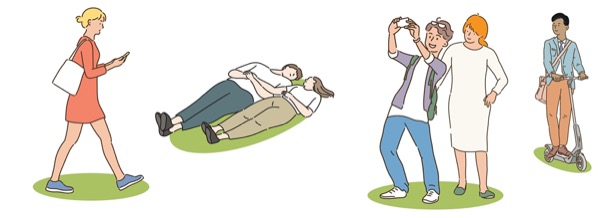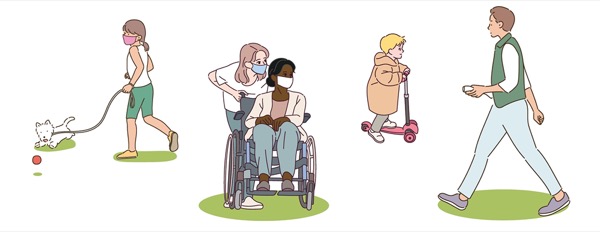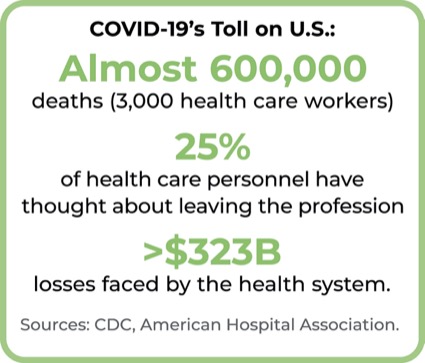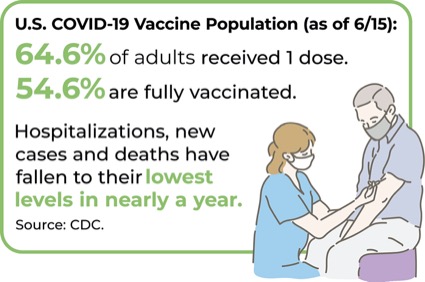The CDC’s recent changes in mask guidance for those who are fully vaccinated gave many people a welcome glimpse of a post-pandemic world, a chance to see family and friends and take part in activities that had stopped for more than a year. However, there are still reminders that the pandemic is not over. One needs only to look outside the United States to see surges in India, Nepal and Japan to understand that global collaboration will be required to end COVID-19.
But with more states lifting masking and social distancing rules, opening restaurants, gyms and grocery stores, and many countries allowing international travelers from areas with low COVID-19 rates, “normal” is settling into a new routine. But what will it take to get there? Infectious Disease Special Edition spoke with several specialists, who all agreed that normal may be a misnomer.
“Are we going back to the old normal or are we going to a new normal? And the answer is clear: It’s a new normal at every level of society,” said William Schaffner, MD, a professor of preventive medicine and infectious diseases at Vanderbilt University School of Medicine, in Nashville, Tenn.
What Will It Take to Get There?
To get there, Dr. Schaffner said, more people have to receive COVID-19 vaccination. “The vaccines have developed a wonderful track record of being safe and effective; and clearly in areas where the vaccine has been used intensively, cases are diminishing, and we are seeing that around the country.”
With more than 52.6% of the total U.S. population receiving at least one dose of COVID-19 vaccine and 43.9% fully vaccinated as of June 16, new U.S. cases, hospitalizations and deaths fall to their lowest levels in nearly a year, according to the CDC.
But these reductions must continue to enable a return to normal, according to Rajesh T. Gandhi, MD, FIDSA, a professor of medicine at Harvard Medical School and Massachusetts General Hospital, in Boston, and the chair of the HIV Medicine Association. “We need to get the case numbers down and get vaccinated,” he said. “The two go hand in hand. By vaccinating, we get case numbers down, and then by getting case numbers down, it makes it possible to be safe when we’re getting back to normal activities.”
None of the experts said SARS-CoV-2 will act like its country cousin—SARS-associated coronavirus—and just disappear. They expect to see continued, sporadic disease, maybe seasonal, maybe year round.
Conventional, nonpandemic human coronaviruses—the ones that cause common colds—tend to be more robust in the colder months. Last year, many people were hoping the heat of the summer would mean a drop in COVID-19 cases and yet, the United States saw a surge during the warmer months, so there is uncertainty about how SARS-CoV-2 will act this year. However, with vaccination, there is definitely downward pressure on circulating virus.
The biggest caveat is the variants. To date, the COVID-19 vaccines have been effective against the variants, but one could emerge that would not be covered by the vaccine, which puts pressure on vaccination efforts to get as close to herd immunity as possible and to reduce transmission.
“I don’t think this is the answer that you want to hear, but the answer is we just don’t know [what the cold weather will bring],” admitted Shmuel Shoham, MD, an associate professor of medicine at Johns Hopkins University School of Medicine, in Baltimore. Having a widely vaccinated population could turn the virus into a “nuisance” that would result in milder disease for most people, but could be a problem for immunocompromised people, as is the case for many respiratory diseases. “I think it will ‘smooth out’ over time because we are doing a lot of things as humans to try to change the trajectory of COVID,” explained Dr. Shoham, who is a member of the Infectious Disease Special Edition editorial advisory board.
Stuart C. Ray, MD, FACP, FIDSA, the vice chair of medicine for data integrity and analytics, and a professor in the Division of Infectious Diseases at Hopkins, is concerned that as masking and social distancing rules change, people will become complacent, the push to get people vaccinated could stall, and some locations could see a surge in the winter. (See what states are doing to incentivize vaccination at https://www.idse.net/ Covid-19/ Article/ 06-21/ Incentives-Offered-to-Boost-COVID-19-Vaccination-Rates-Tackle-Hesitancy/ 63765)
“This whole notion of approaching herd immunity, it’s not a sharp finish line. It’s a gradient of risk that we travel through from where we started—which was a high rate of infections—to nearly 100% of people immune and we have no outbreaks,” said Dr. Ray, who is a member of the IDSE editorial advisory board. “As we go through that gradient, we’ll go from widespread surges to milder cases of disease.
“So, if we get more people vaccinated, then when the fall does come, rates will stay low, and things will be more normal,” Dr. Ray said, but he added that some sections of the country that are resisting vaccination could see a “horrible” surge.
“There is reason to be hopeful that we will drive it down so that it’s either milder, which would obviously be a good thing, or that there are fewer and more contained outbreaks,” said Dr. Gandhi, who is also a member of the Infectious Disease Special Edition editorial advisory board.
Back to the Future
With almost 600,000 deaths in the United States alone—more than 3,000 among health care workers—and more than 3.5 million worldwide during the pandemic, people cannot just pretend this never happened, noted Susan Mashni, PharmD, BCPS, the vice president and chief pharmacy officer at Mount Sinai Health System, and an associate professor at the Icahn School of Medicine at Mount Sinai, in New York City.
“There’s a lot of post-traumatic stress and psychological issues. It’s bad for health care workers out there,” said Dr. Mashni, who predicted a staff exodus when COVID-19 is finally over. “There are going to be underpinnings [from that]. We have to do better at taking care of ourselves and each other.”
A recent survey from Morning Consult appears to support Dr. Mashni’s view: About 25% of health care personnelhave thought about leaving the profession because of COVID-19.
In addition, America’s hospitals and health systems faced historic challenges with the surge of critical COVID-19 patients and the dearth of more routine testing and procedures, such as outpatient surgeries. The costs of preparing for that surge were astronomical, and hospitals lost billions of dollars in essential revenue from the stay-at-home orders, which led to a downturn in nonemergent care and an increase in care for uninsured patients. The American Hospital Association expects losses of more than $323 billion in 2020, when all the tallies are done.
At least 50 hospitals declared bankruptcy or closed in 2020, and hundreds more, especially in rural and underserved areas, are at risk. A 2021 report by the Chartis Center for Rural Health found that 77% of total revenue for rural health care facilities is tied to outpatient services (bit.ly/34LwZ2M-IDSE).
“We know the toll COVID has taken in terms of the hundreds of thousands of deaths, the toll it’s taken mentally, and then the economic toll,” Dr. Gandhi said.
“Financially, it’s been a big hit, and emotionally, it’s been a big hit,” Dr. Mashni agreed.
The pandemic will continue a trend that was started before COVID-19, they predicted. Site-of-care optimization will continue to take people out of the hospital, and hospitals that want to regain their financial footing will have to adapt to changing care models, according to Bonnie Kirschenbaum, MS, FASHP, FCSHP, a pharmacy consultant and an expert in reimbursement issues.
“It is not going to go back to what it used to be,” Ms. Kirschenbaum said. “There is a whole chain of events, from inpatient moving to outpatient, moving to ambulatory, moving to a freestanding facility, and moving to therapy at home,” she said. “It’s not only just infusion therapy at home, but to the whole hospital-at-home concept.”
Just as health systems purchased stand-alone surgery centers, they are going to have to invest in providing home care because that is what third-party payors want to see, and pricing for those services will have to be competitive, she warned.
Payors are not the only ones who like the idea of home care. Patients like it, too, and telemedicine will probably continue to be part of providing patient care.
“People feel a lot more comfortable doing telehealth visits, and they’ve seen the benefits,” Dr. Mashni said. “That’s one additional tool in our tool box that we can use to improve care for patients. We’ve also done a lot more with remote patient monitoring.”
Dr. Shoham, who manages immunocompromised patients, particularly those who’ve undergone a transplant, agreed that his patients loved the convenience of telemedicine. “In the past year, I’ve provided a good amount of clinical care from a distance,” he said.
He discussed one patient who lived a long distance from Hopkins. “She’s a mom, so driving three hours [is] a huge disruption for something that could be done by telemedicine,” Dr. Shoham said.
Now that patients and providers have gotten comfortable with telemedicine, “we are going to have to be really open to people saying, ‘I can’t do that [trip] anymore.’
Now that patients and providers have gotten comfortable with telemedicine, “we are going to have to be really open to people saying, ‘I can’t do that [trip] anymore.’
“It’s more convenient [to do a telemedicine visit], and if you are really sick, the last thing you want to do is get up and go to your doctor’s office. And sometimes, you go to talk, to touch base, and a traditional visit really isn’t necessary,” he explained.
However, for telemedicine to be equitable, the country has to address the digital divide, Dr. Gandhi said. “There is an inequity around access to digital technologies, and equitable distribution of care is critical. For some people, the ability to see their clinician virtually has helped, and I hope some of that persists,” he said.
COVID-19 was a multisystem disease, so it has been crucial for practitioners to work closely together. Dr. Gandhi said, “We worked a lot more closely with our colleagues in other specialties just by necessity, and so that has brought us together with our pulmonary colleagues, our nephrology colleagues, our cardiology colleagues.
“COVID-19 has brought the entire medical community together around a common goal,” Dr. Gandhi said, predicting that these collaborative benefits will continue.
The New Normal
An important part of getting back the daily routines is having children return to in-person learning, the experts said.
“Many, many schools will open fully this fall, as they should,” Dr. Schaffner said. “By now literally every adult who works in the school, not only teachers, but the administrators, the coaches, folks who work in the cafeteria, the custodians, the bus drivers—everybody should be vaccinated by now.”
Moreover, with the FDA lowering the age of vaccination to 12 years, many of the children also will be vaccinated. “Now, everybody is not going to be vaccinated,” he warned. “Obviously, there are going to be hesitant parents, but I think schools can be very safe.”
It will still be important to maintain disinfection and air handling, and some schools might require masks and maintain social distancing, where appropriate.
Dr. Ray also thought having a highly vaccinated group will be important for the return of in-person learning. “We need to vaccinate them; that will make it possible to go back to normal classroom teaching,” he said, but he agreed that vaccine hesitancy will play a role. “My guess is we are going to have a natural experiment, where we will find out what the price [of that hesitancy] is,” he said, adding there could be sporadic cases tied to schools if the vaccination rates are not high enough.
When the country was sequestered, many businesses found success working from home, and while some companies have decided to maintain that model, others have asked employees to return to the workplace. Many, however, have decided on a hybrid model: working from home some days and in the office others. “I would think virtually every company and organization is currently thinking about and wrestling with, and inquiring of their employees, ‘How is that going to work?’” Dr. Schaffner said.
For many people who work in an office setting, there are quality-of-life issues to working from home: They don’t have to commute, saving time and money.
Cleanliness Is Next to Healthiness
Throughout the pandemic, there was a concerted effort to keep public places—including grocery stores, subways, buses and trains—clean. “We are going to have to be more cognizant of keeping our classrooms clean. And I’ve heard a lot of people say they appreciate the benefit of how clean restaurants are. That might be part of the new normal,” Dr. Mashni said.
Another positive aspect of the new normal that experts hope will continue is awareness of how respiratory diseases are transmitted, and a willingness to prevent them. Experts are hopeful that in addition to people staying home when they are sick, people will continue to wear a mask in crowded places during flu season and to practice good hand hygiene. The 2020-2021 influenza seasonwas practically nonexistent, and experts attribute that to the mitigation actions taken against COVID-19.
“People’s patterns have changed,” Dr. Mashni said. “They’ve learned different ways to be able to minimize their exposures to others. I think that will be part of our new normal. People will be more cognizant about shaking hands and unnecessarily sharing germs,” she said.
“If somebody pulls out a little [container of] Purell and does their hands, nobody’s going to look twice at them today. It’s just normal—and maybe even wise,” Dr. Ray said.
Some people don’t want the world to be exactly the same. “We want to be in a better place. COVID has shown us what happens when you have an inadequate public health response, when you don’t have equitable health care access for all, including the most vulnerable,” Dr. Gandhi explained.
“So, if that’s normal, then I don’t think we want to go back to that,” he said. Instead, “we want to build on what COVID has taught us: to take stock of what happened and build on it so that we are in a better place next time.”
The sources reported no relevant financial disclosures.
This article is from the June 2021 print issue.







